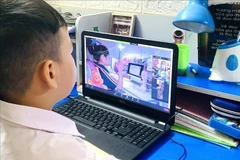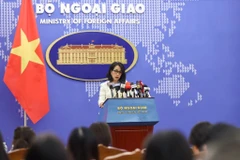Hanoi (VNA) - The influence of the "Nhua Song" (Vitality) newspaper, the "voice" of the Hanoi student resistance movement, along with various activities of the youth in the capital during the occupation kept the enemy on edge. The occupiers sought ways to suppress, counter, and arrest individuals in an effort to extinguish the revolutionary movement.
However, it was precisely from these hardships that generations of youth and students in the capital were forged and continuously matured, becoming steadfast revolutionary soldiers in the struggle for national liberation and reunification.
At the beginning of the 1950-1951 school year, the Trung Vuong student resistance group, led by Do Hong Phan, announced a plan to celebrate the 1950 Autumn-Winter Border Campaign Victory through activities such as hanging red flags with yellow stars, setting off firecrackers, and distributing leaflets.
On November 7, 1950, that celebration was a resounding success, uplifting the spirits of the youth in Hanoi, causing the enemy to be “on edge.” A number of students from Trung Vuong, including Phan, were arrested.
“I and other students had to endure torture with electric shock machines,” Phan recalled, shuddering. However, she resolutely refused to disclose any information.
After more than two months of being imprisoned at Hoa Lo Prison, the French colonialists released her on January 21, 1951 because she was not yet 18 years old.
Another member of the youth resistance movement who was imprisoned at Hoa Lo Prison was Duong Tu Minh, the youngest son of Professor Duong Quang Ham.
While studying at Chu Van An School, Minh and his older sister, Duong Thi Cuong published secret newspapers, distributed leaflets, and hung flags to promote the resistance movement.
In the summer of 1950, the enemy arrested more than 100 students, including Minh and his sister. However, due to lack of evidence, they were released after two weeks.
Shortly after being released from prison, Minh was admitted to the Hanoi National Salvation Youth Union. He was one of the active members involved in printing and distributing the secret "Nhua Song" newspaper of the Hanoi student resistance movement.
In October 1952, a tip exposed the printing facility in Minh's home. At just 17 years old, he was arrested for the second time.

The enemy realized he was a prominent member of the movement, so upon entering Hoa Lo Prison, he received “special treatment.” He was tortured by having wires clamped to both ears and subjected to electric shocks throughout his imprisonment.
He was interrogated about many issues related to the "Nhua Song" newspaper, but he refused to say a word. Although the colonialists wanted to impose heavy charges on Minh and his comrades, they ultimately lacked sufficient evidence, so they temporarily released Minh and his three friends.
According to Minh, despite the harsh prison term with many forms of brutal torture, the enemy could never subdue the will and patriotism of the communists. The prisoners remained resolute and determined, finding ways to dig tunnels and escape. Moreover, during this time, Minh continued to receive support, training, and education from the fellow communists.
Political and general education classes, along with language and public speaking courses, were secretly organized by the Party cell at Hoa Lo Prison. Lacking educational materials, they used the cement floor as a blackboard and wall chalk for writing, erasing it after the lessons.
Time might blur many things, but for Minh, the days spent fighting against the enemy in that "hell on earth" could never be forgotten.
Minh was asked to teach fellow prisoners, and those who knew French were assigned as representatives for prisoners to communicate directly with the guards and fight for the rights of their fellow inmates.
Another revolutionary at Hoa Lo Prison was meritorious teacher Nguyen Tien Ha (born in 1928), a member of the Hoang Dieu National Salvation Youth Union (Hoang Dieu was a secret name for Hanoi).
In 1949, Ha was an officer of the Hanoi Military Command. During a fierce battle against the enemy, he was captured in May 1950 and taken to the Secret Police Office (now the headquarters of the Hanoi Department of Public Security at 87 Tran Hung Dao street).
Ha and some other comrades managed to break the wall to escape from prison, but on their way to the revolutionary base, they were recaptured by the enemy. This time, he endured far more brutal torture.
“They hung me from the beams and applied electric shocks, then submerged me in water to the point of suffocation, but I was determined not to reveal any information,” he recalled.
After this brutal beating, he was taken to Hoa Lo Prison. There, thanks to the care and medicine from his comrades, his health gradually improved. He was elected to the Party cell and later became the secretary of the Party cell at the prison, continuing the struggle while organizing classes in general knowledge, politics, and foreign languages.
At the end of 1952, when the French colonialists could not convict him, they released Ha. Immediately after his release, he sought to reconnect with his unit, operating semi-clandestinely under the name Professor Tran Huu Thoa. From then on, he continued his revolutionary activities in association with his educational career.
The persistent and courageous revolutionary struggle of the Hanoi people significantly contributed to the “Hanoi Day of Victory.” After nine years of resistance against the French colonialists, on October 10, 1954, the liberation army marched into the capital, with the national flag proudly waving atop the Hanoi Flag Tower./.




























